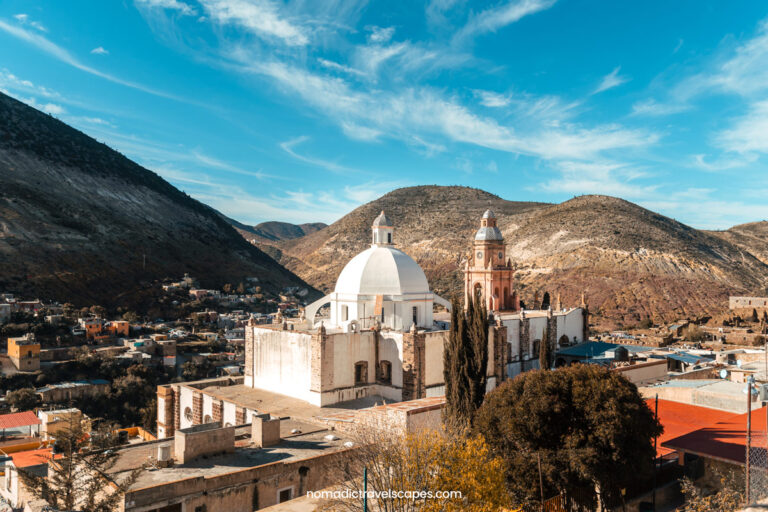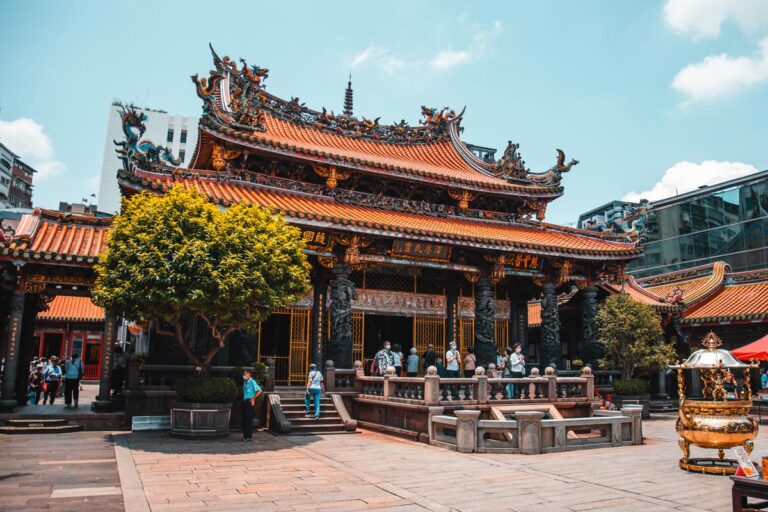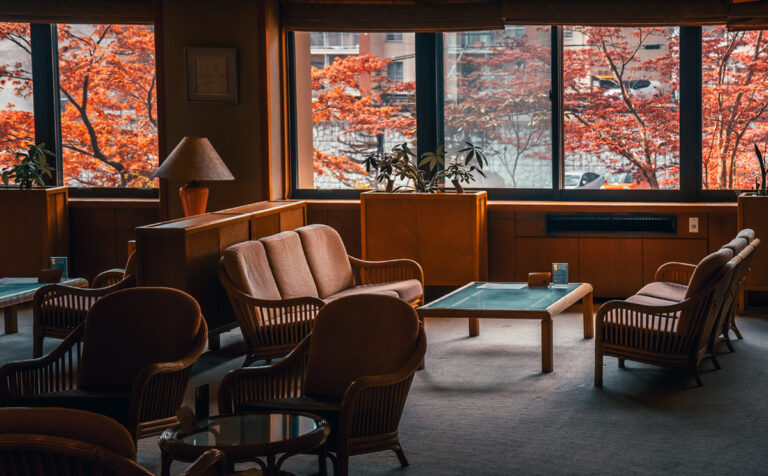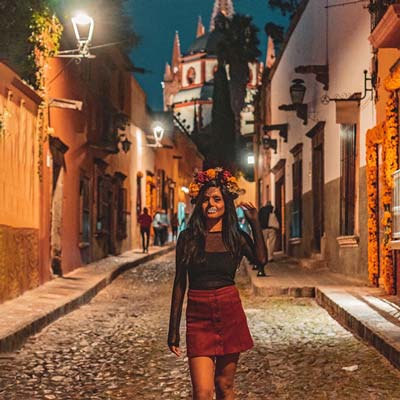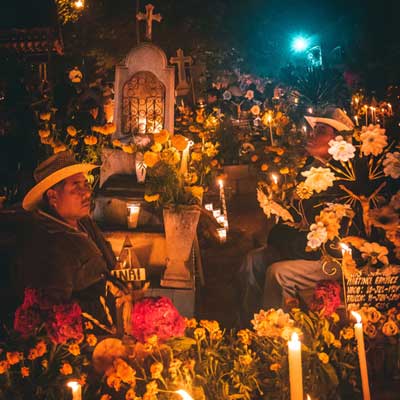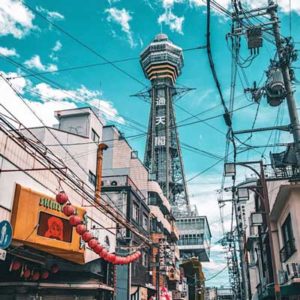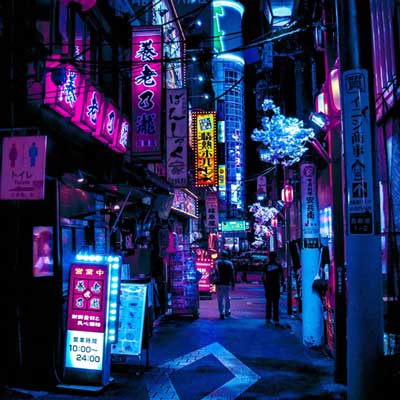In the past seven years, I’ve explored plenty of Pueblo Mágicos in Mexico. Towns full of color, ancient rituals, strange festivals, and intense mystique, but none of them quite beat the ethereal aura of Real de Catorce.
What was once a bustling silver mining town, Real de 14 (or just Real) is now a small city in San Luis Potosí. Sitting high in the Sierra de Catorce mountain range, this destination feels frozen in time. Fewer than a thousand people live here now, yet there’s an unexplained life energy moving through the air. Perhaps it’s the echo of horses’ hooves on stone streets, cowboys in wide-brimmed hats riding like it’s still the 1800s. Or maybe it’s the Wirikuta pilgrimages, where Huichol shamans walk for days through the desert to reach sacred ground.
Real de Catorce, despite its “ghost-town” label, is far from dead.
This visitor’s guide to Real de Catorce will equip you with everything you need to plan your trip. Get to know how to get to Real de 14, when to go, what to see, and the lore behind abandoned buildings and deep, dark mine shafts.
If you’re drawn to places outside Mexico’s usual tourist trail, Real de Catorce should move to the top of your list.
Why Visit Real de Catorce?
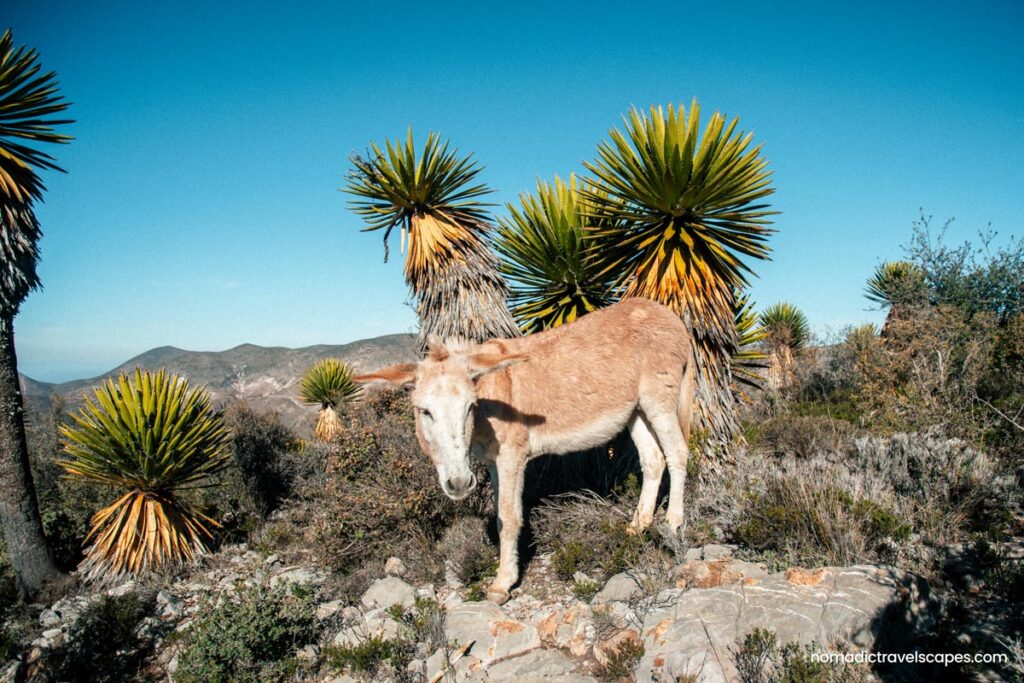
For travelers who want to skip textbook hot spots like San Miguel de Allende and Cancun, and prefer to go off the beaten path (literally off it), Real de Catorce is the perfect choice.
Back in the day, after the silver boom collapsed and prices dropped, this dry, isolated town was more or less abandoned. The mining tunnels went quiet, people packed up, and the desert took over. Lately, however, it’s been getting the attention it deserves. Thankfully, it’s not the kind that floods a place with tacky souvenir shops and overpriced hotel chains.
For me, the immediate pull I felt when I arrived at Real de Catorce is hard to explain.
And at the risk of sounding like a flower-crown-wearing, peace-sign-throwing girl, there’s something in the ground here that you just feel. It’s not a phenomenon you can spot in photos or guidebooks. You have to make the journey, walk the ancient streets, sit in silence, and stare at the star-filled skies to feel it.
We’ve all seen those sepia-toned cowboy films set in dusty Mexican deserts with the wind kicking up mini tornadoes of dry sticks and tumbleweeds. In Real de Catorce, that scene is real life.
It’s been used for movies, and the band alt-J picked it as a backdrop for their music video.
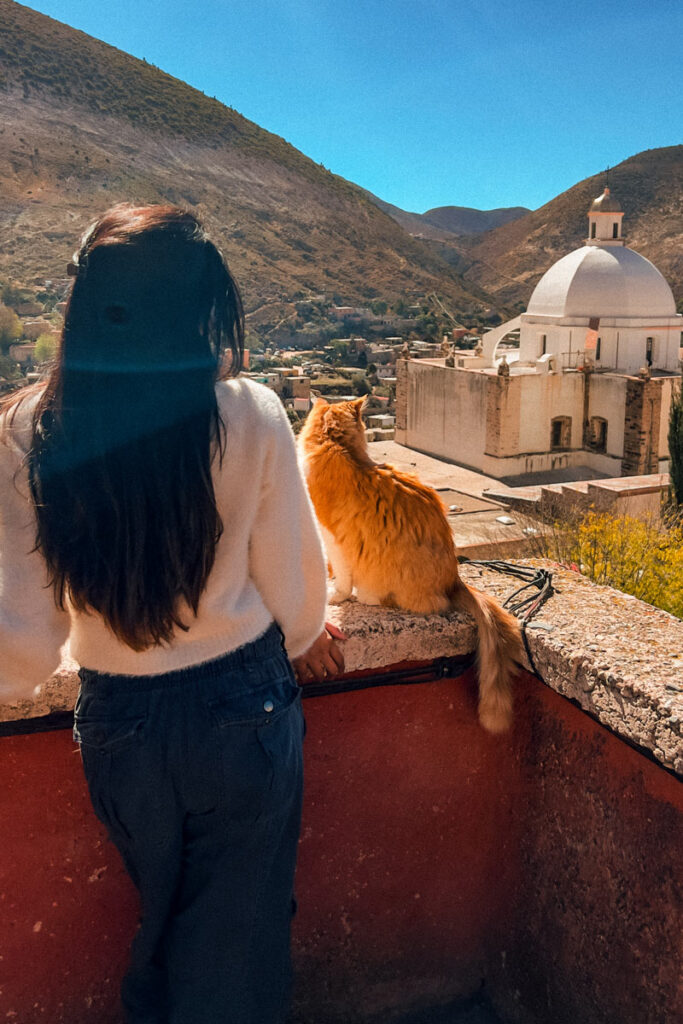
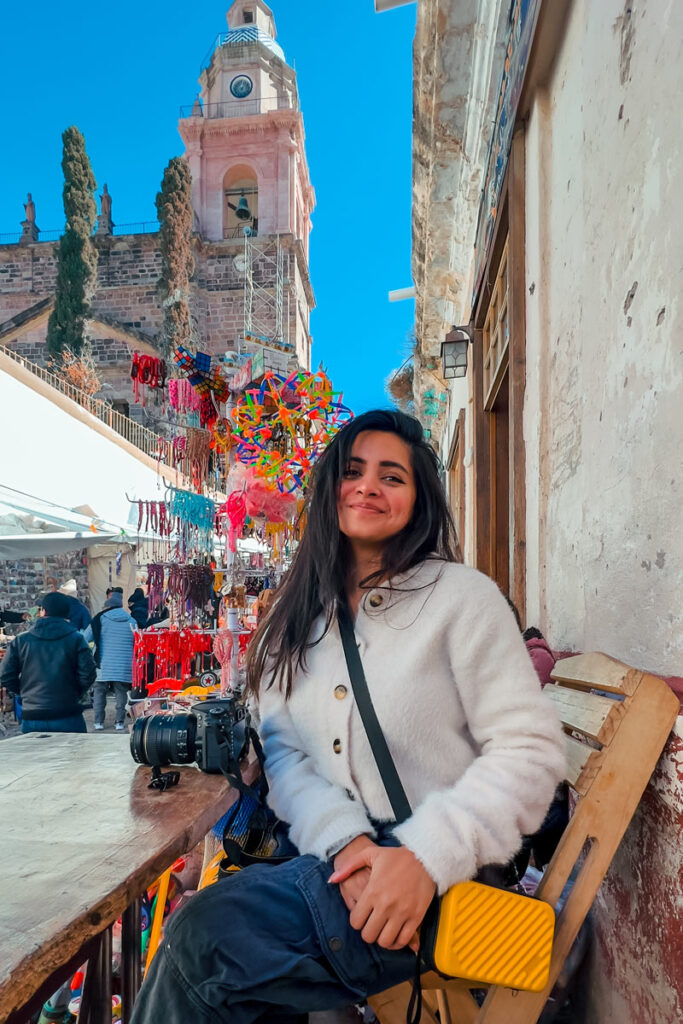
Having said that, if cobblestone streets, slow days of doing nothing but wandering, exploring crumbling stone buildings, and taking in the wide open desert don’t sound like your thing, Real de Catorce may not be for you.
Compared to popular Mexican destinations, Real de Catorce is still flying under the radar. And honestly, with how tricky it is to reach, I don’t see that changing anytime soon, which might be a good thing. It means the few who make the pilgrimage-like trip to reach Real de Catorce, get to experience something most people won’t.
How To Reach Real de Catorce
There’s no airport or direct bus line into Real de Catorce. The closest major airport is Ponciano Arriaga International Airport in San Luis Potosí. From there, you can rent a car or catch a bus from the San Luis Potosí central terminal to Matehuala. Once in Matehuala, you’ll need to find local transport—either a shared van or a bus—that takes you up the winding mountain road to Real de Catorce.
By Car
It’s possible to drive to Real de Catorce, which has fairly drivable roads up to Matehuala. Once the cobblestone path begins there are sharp rocks, steep inclines, and all. So expect a slow, bumpy ride. It’s manageable, but make sure your car (and suspension) can handle it.
By Public Transportation
To reach Real de Catorce, you’ll need to get to Matehuala first. From there, you can reach Real de Catorce by shared van (colectivo) or taxi.
So let’s break down the first leg of the trip: Getting to Matehuala.
How to reach Real de Catorce from Mexico City
Recommended Route: Mexico City > Matehuala > Real de Catorce
Take a taxi to the North Bus Terminal (Terminal Central de Autobuses del Norte) in Mexico City.
Once there, head to the Transportes del Norte or Ómnibus de México counters. Both run regular buses to Matehuala. They’re not luxury-level, but they’re comfortable enough, with air conditioning, reclining seats, and scheduled stops for snacks and bathroom breaks. The ride usually takes around 7 to 8 hours.
How to reach Real de Catorce from San Miguel de Allende
Recommended Route: San Miguel de Allende > Querétaro > Matehuala > Real de Catorce
There’s a direct bus from San Miguel de Allende to Matehuala operated by Autobuses Anáhuac, departing at 7:50 PM and arriving around 1:20 AM. While it gets you there without transfers, arriving at that hour can be awkward—Matehuala is a quiet, regular town with not much going on at night. If you choose this option, it’s best to book a hotel near the bus station and continue to Real de Catorce in the morning.
For solo female travelers or those new to travel in Mexico, a longer but more comfortable alternative is to go via Querétaro. Take an early ETN bus from San Miguel de Allende to Querétaro, then transfer to a Grupo Senda bus heading to Matehuala. This way, you’ll arrive during the day when transport to Real de Catorce is easier to navigate.
EXPRESO VANCED
Once you’re in Matehuala, head to EXPRESO VANCED and buy a ticket for the colectivo (shared van). The ticket price should be about 100-200 pesos per person. Wait in the boarding area to catch a ride up the mountain to Real de Catorce.
This is the cheapest way to reach Real de Catorce, but it does require a bit of planning. Shared vans leave at 8 am, 2 pm, and 5 pm. As you can see, the colectivos aren’t frequent, and depending on your arrival time in Matehuala, you might miss one or find it already full. If that happens, you’ll need to wait for the next available van, which could take a while. Each passenger is typically allowed one small suitcase, which is loaded into the back of the van, so pack light if you’re going this route.
Location for shared van from Matehuala to Real de Catorce:
EXPRESO VANCED S.A DE C.V. 📍Altamirano 104, Centro, 78700 Matehuala, S.L.P.
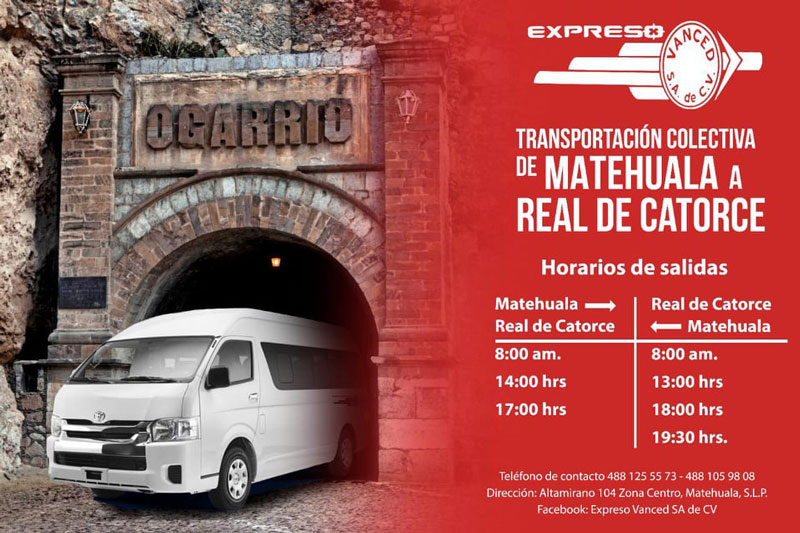
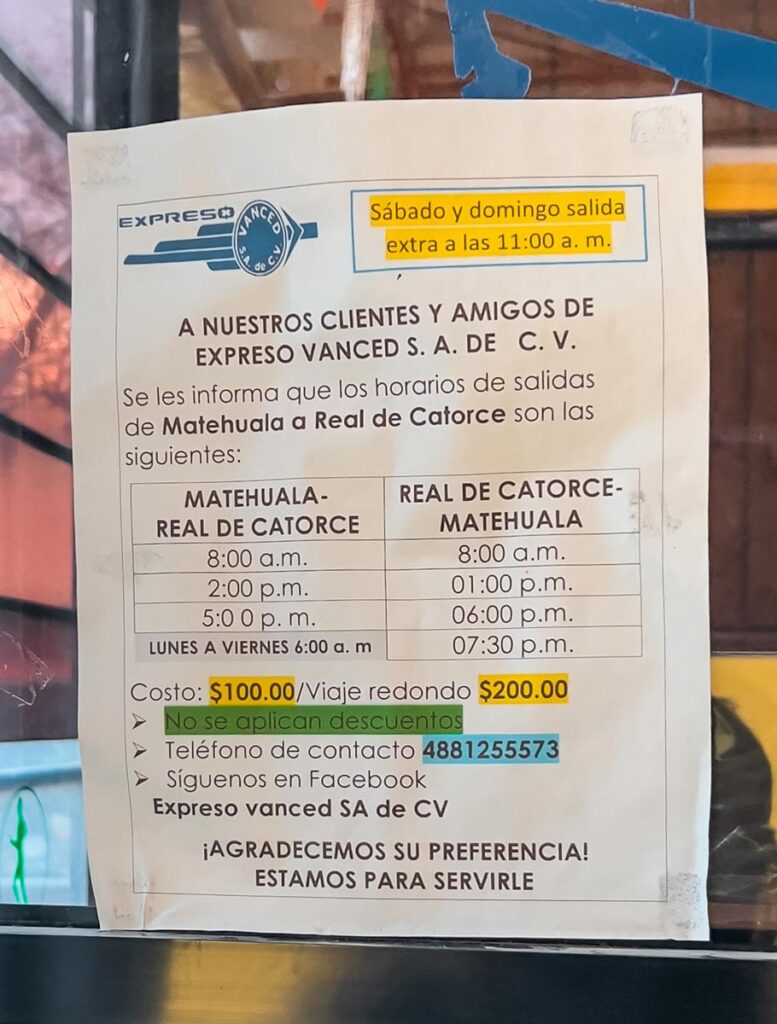
The van, taxis, or even your personal car takes you on a winding two-hour ride through the mountains, eventually passing through the 2 km-long Ogarrio Tunnel—a long, narrow route carved straight through the rock. Going through it feels a bit like crossing into another world. It’s the only way in and out of Real de Catorce, and during busier months, you might face a short wait. The tunnel is one-way only, with traffic taking turns from each side of the tunnel.
Special Routes: Certain highway buses like Frontera from cities like Monterrey, end the trip at Estación Catorce, which is quite far from the main town. Hail a ride on the jeeps (Willys) to finish the last 12km to reach Real de Catorce.
Getting Around in Real de Catorce:

Walking
Once you’ve checked into your hotel and dropped your bags, head out on foot. The town’s small enough that walking is the easiest way to see it. The dirt roads wind through old stone buildings and narrow alleys, and since cars aren’t allowed in the main historic center, you won’t be dodging traffic, just the galloping horses.
Horseback Riding
If you’re keen to get beyond the center or feel like leaning into Real de Catorce’s cowboy vibe then horseback is the way to go. It’s great for getting to the far-reaching hills that would otherwise be exhausting to get to by foot.
Willy Tours
To explore abandoned mines, desert landscapes, and old haciendas outside of the town, you can hop on a Willy Tour, named after the vintage jeeps used for the ride. These are loud, bumpy, and worth it. You’ll find guides offering tours around the main square or through your hotel.
Things to do in Real De Catorce
Real de 14 Mexico, is less about racing through a checklist and more about observing and taking in the surreal atmosphere of the ancient city.
1. Wander the Mainsquare of Real 14
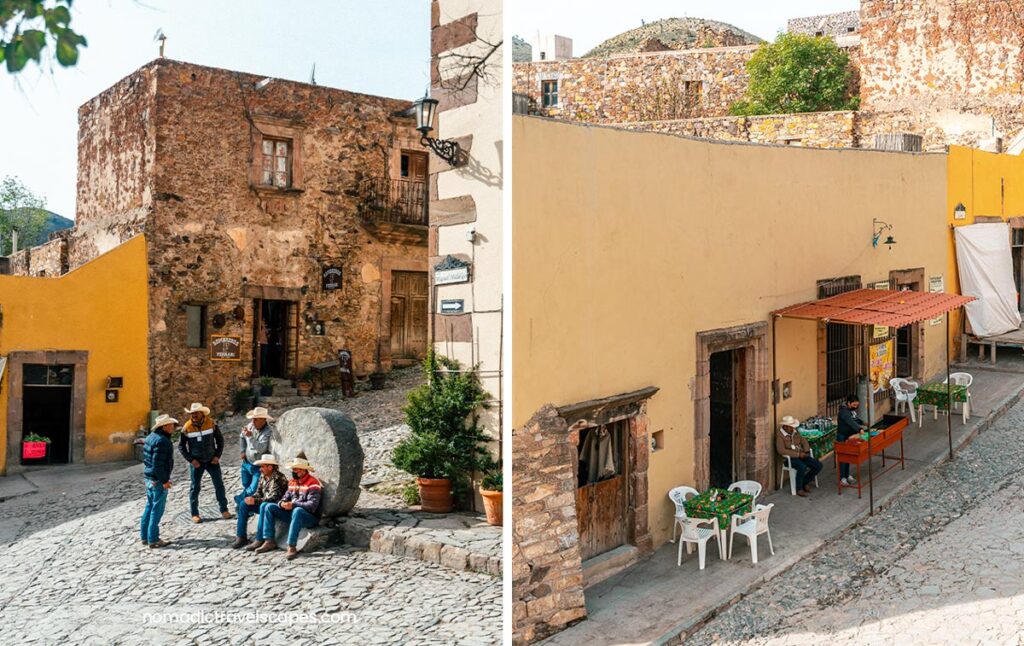
Real de Catorce’s downtown is tiny but full of life. Street vendors serve fresh juice, hot gorditas, and sweet treats, while guys with dreads sell handmade, psychedelic-inspired jewelry.
You’ll also find locals selling oils and gels made from the region’s magic plant which is said to have healing properties. Whether or not they actually work is another story as their authenticity and potency can be hit or miss.
It’s still a great spot to pick up textiles, browse crafts, or sit back and take it all in. At the center is Templo de la Purísima Concepción, a stone church that dominates the square.
2. Horse Riding to Cerro el Quemado
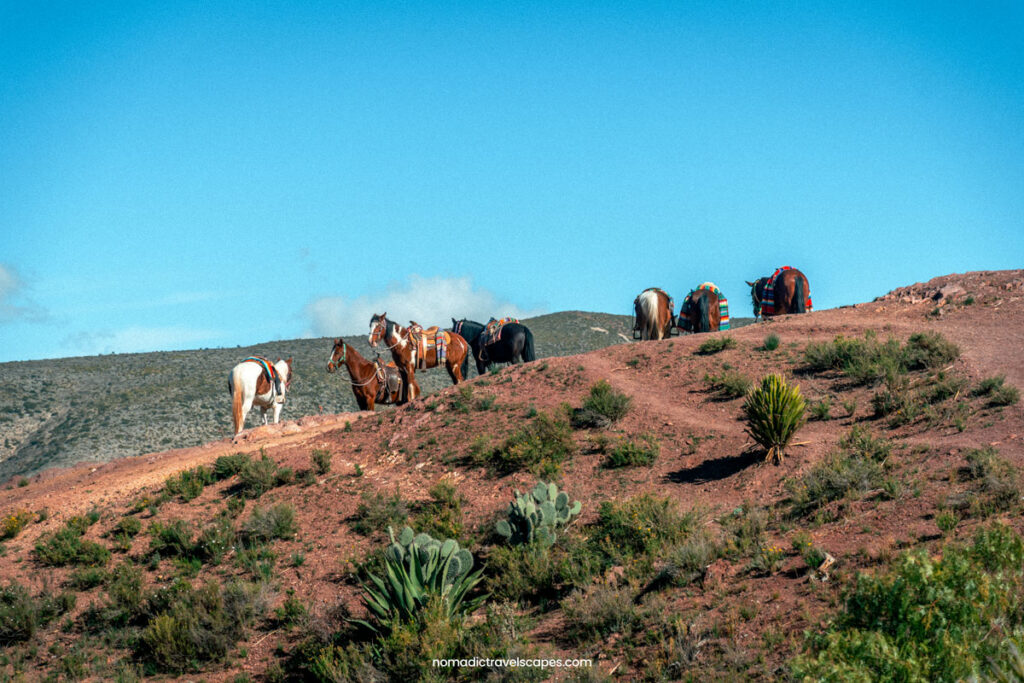
Renting a horse and riding up to Cerro Quemado is hands down the best thing to do in Real de Catorce.
We met up with a cowboy with the coolest name – Eluterio AKA Charal- in the downtown of Real who led us to a stable where we picked the horse we wanted to ride on and set off on. Once we reached the base of the hill, we got off and continued on foot.
There’s a small shop where you can grab water and snacks before starting the climb. I had no idea what was waiting at the top, but the walk itself was so idyllic, with Joshua trees, agaves, wild cacti in every shape and size around, and not a single other person in sight.
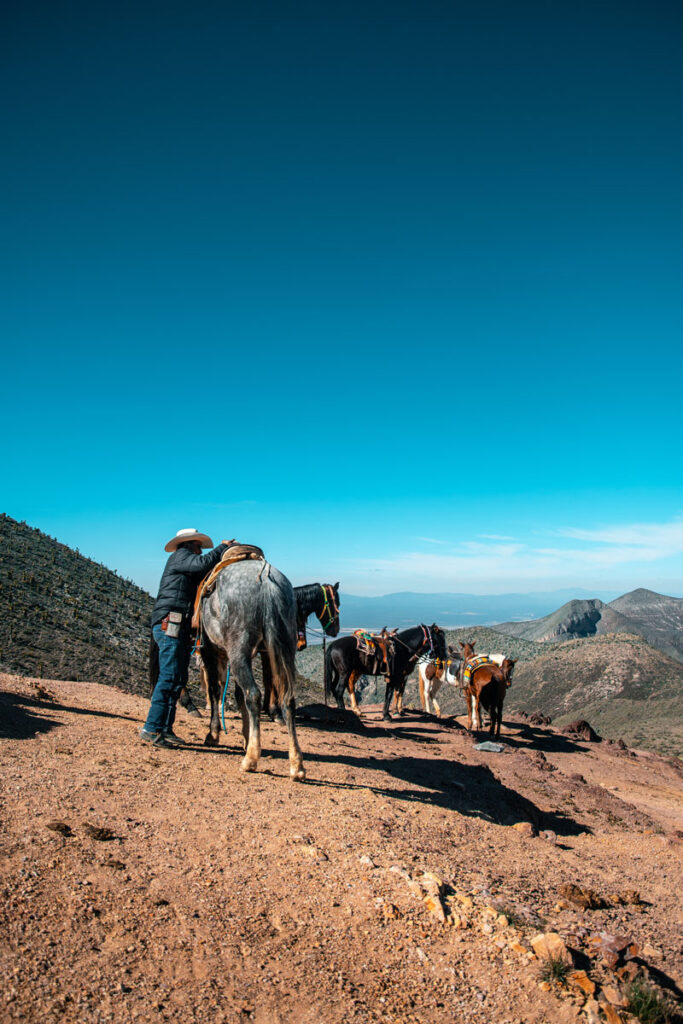
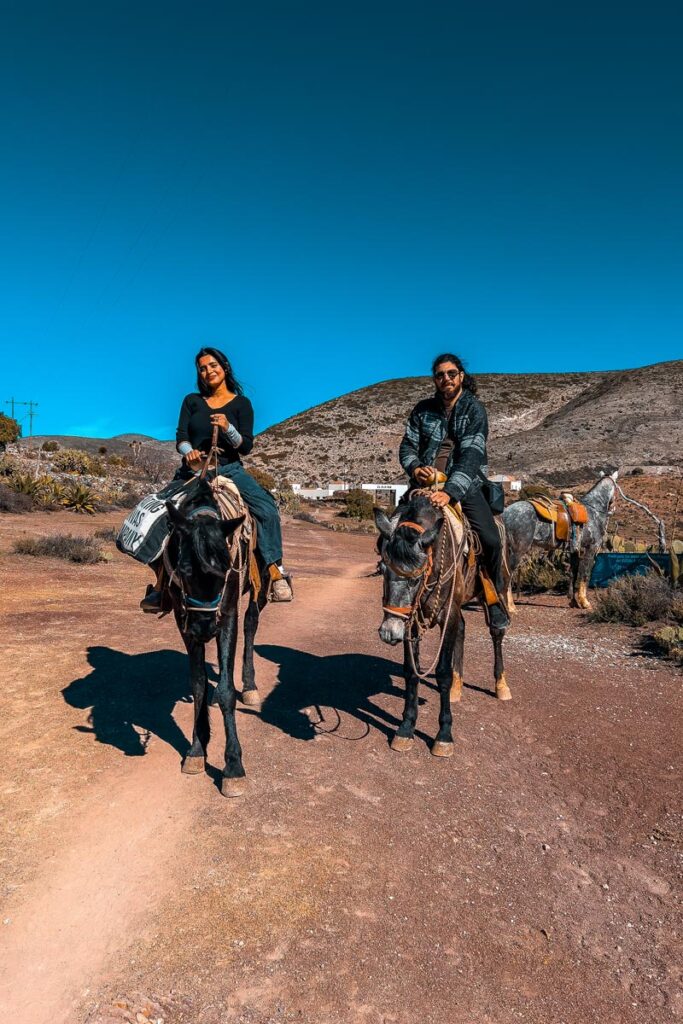
At the top, we reached the home of a Wixárika family—the Indigenous people of this region, also known as the Huichol. Cerro Quemado is a sacred site for them. Every spring, Wixárika groups from far-off regions hike up this mountain range for rituals and offerings. But the family we met had been living there for years.
The head of the family did a cleansing ceremony with me in a cave and then introduced me to his daughter who was making beautiful textiles by hand. Next to her was a peyote plant, a cactus sacred to the tribe. (More on that mystical plant further below.)
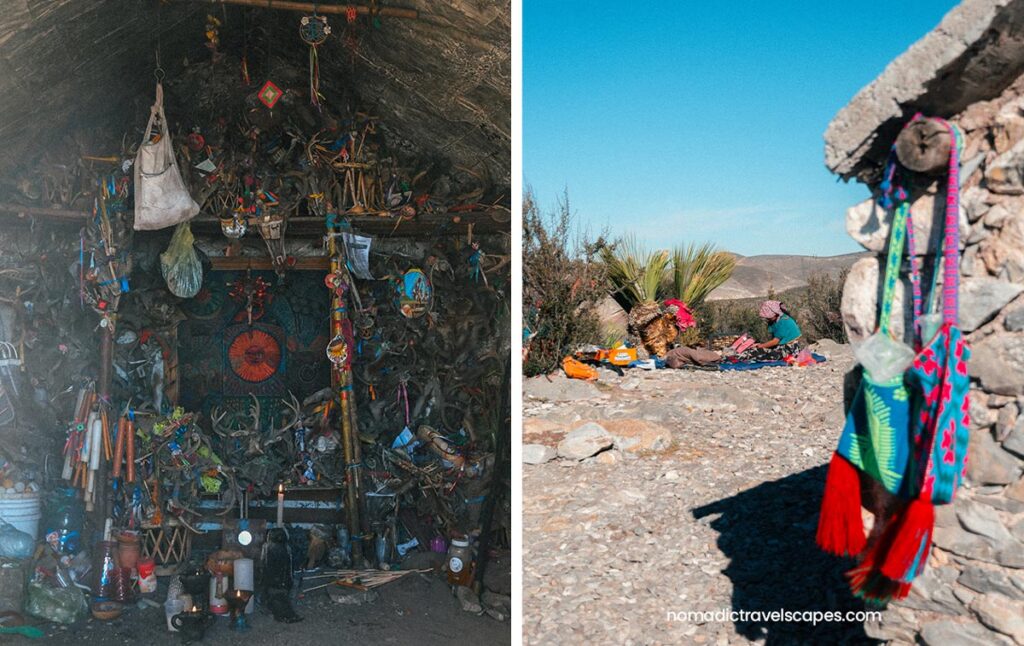
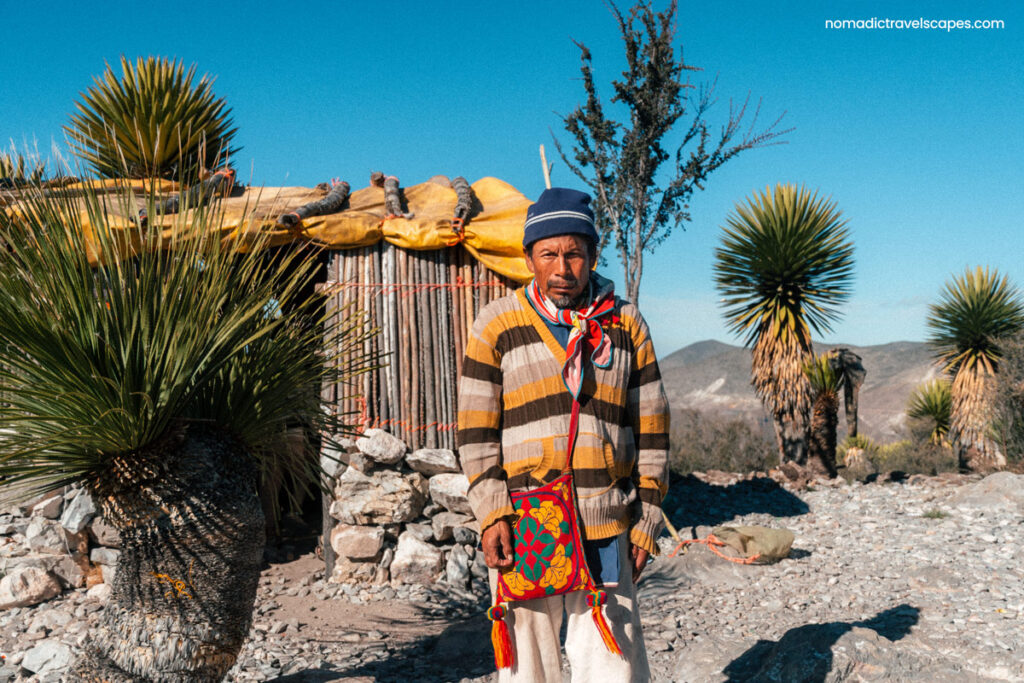
After spending a few hours around the area, spotting donkeys and geckos, we headed back to Real de Catorce’s main square. Along the way, our guide pointed out a lone cabin in the middle of nowhere. It’s available to rent, though it has no running water or gas. Still, judging by the photos he showed us of the Milky Way-filled night sky, that’s reason enough for some people.
3. Take a Willy Tour
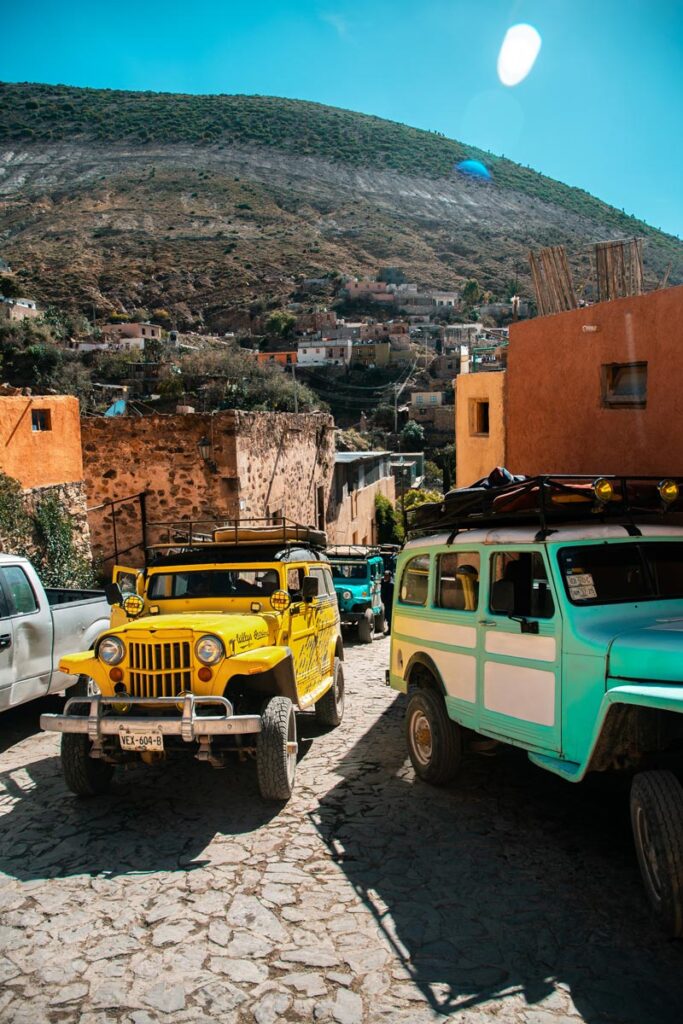
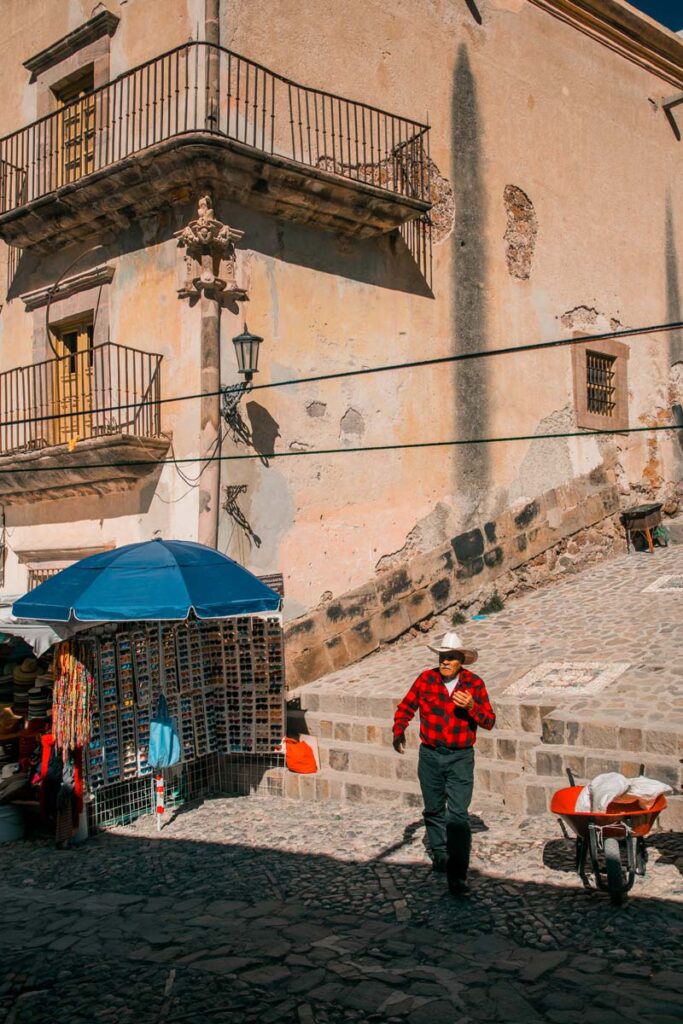
Where else can you ride through desert terrain in a World War II-era jeep? A rainbow lineup of Willys waits outside the main square, ready to take you on a wild ride through the hills and toward the old mining sites scattered around town.
We chose to stand on the edge of the jeep, clinging to the sides, and honestly, the adrenaline rush and the views were insane. But fair warning: the roads are narrow, the drops are sharp, and the curves are no joke. If you’re not up for a thrill ride, it’s probably better to grab a seat inside and hold on tight.
4. Visit the Puebla Fantasma (Ghost Town)
You can rent a horse or get a good workout hiking up to the ghost town of Real de Catorce. This is where the remnants of the old mining village lie scattered across the hillside.
There are crumbling stone walls, empty structures, and the eerie stillness of a place long abandoned. Some of the mines are open to walk through. You won’t see much because it’s pitch black but that heavy, quiet air inside is unique to such sites.
5. Stop by Socavón de la Purísima
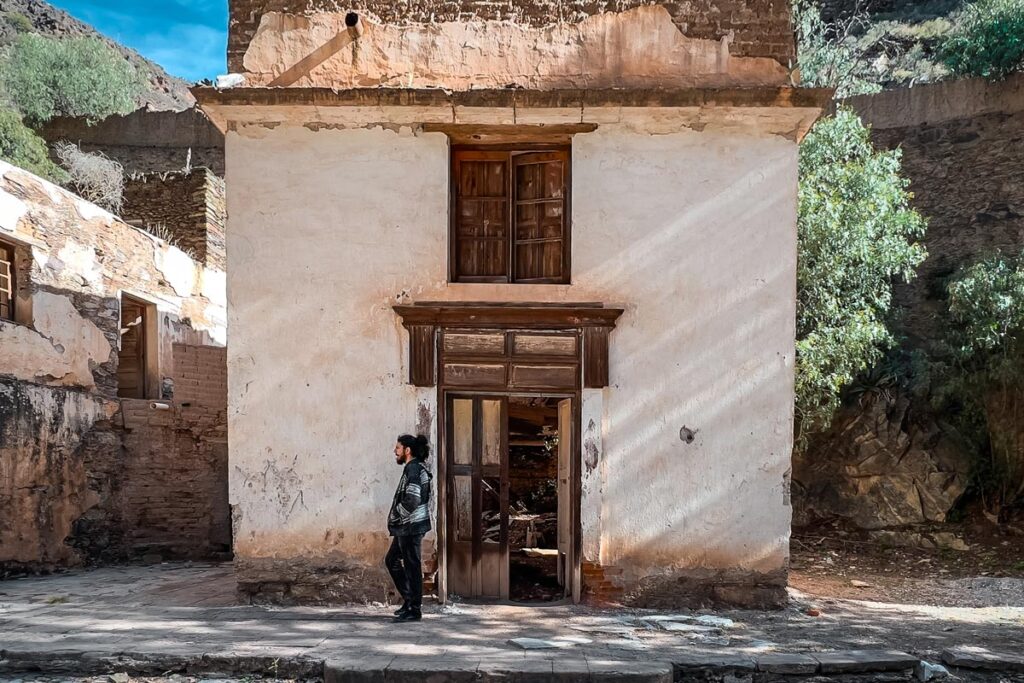
Another abandoned site worth checking out is Socavón de la Purísima. The remains of buildings like a collapsed chapel, a chimney jutting up into the sky, and parts of an old warehouse can be spotted. The mine entrance here is known for the sharp gust of wind that blows out from its mouth.
6. Admire sacred peyote plants
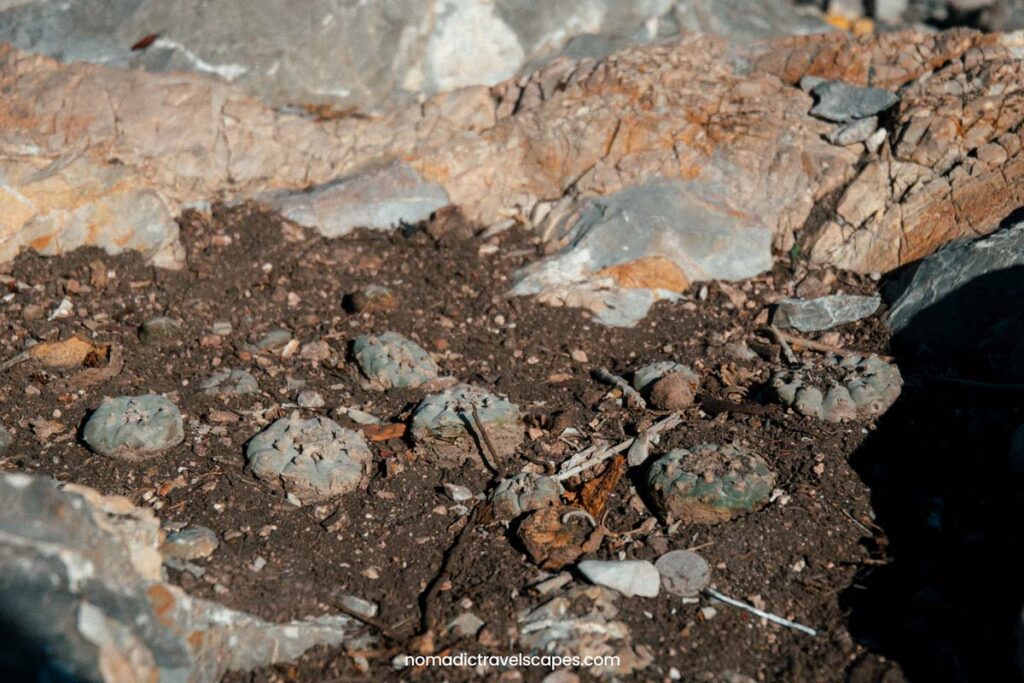
Some Willy tours include a stop to see hikuri (peyote) before heading toward the old Real de Catorce train station. These small, thornless cactus plants contain mescaline which is a naturally occurring psychedelic that famously inspired artists, musicians, and entire movements. Fans of The Doors, and those curious about the magical power of this plant should read the book The Doors of Perception: Huxley, Aldous.
But for the Wixárika, peyote isn’t a trend or a trip. It’s sacred. In their ceremonies, pieces of peyote are consumed to communicate with ancestors, spirits, and deities. Much of their intricate, colorful artwork is said to be a direct result of the visions and symbols seen during these ceremonies.
Lovingly, Peyote is known as the abuelo (grandfather), which makes sense because a single adult cactus can take almost 50 years to grow.
While it also exists in other desert regions of Mexico and parts of the U.S., the largest concentrations are in the San Luis Potosí desert. But overharvesting, often by outsiders with no connection to the culture, has pushed the plant toward endangerment. Trafficking and careless consumption are causing real damage, both ecologically and spiritually.
So if a tour you’re on encourages you to try it, first consider these factors.
7. Purchase Wixárika Art
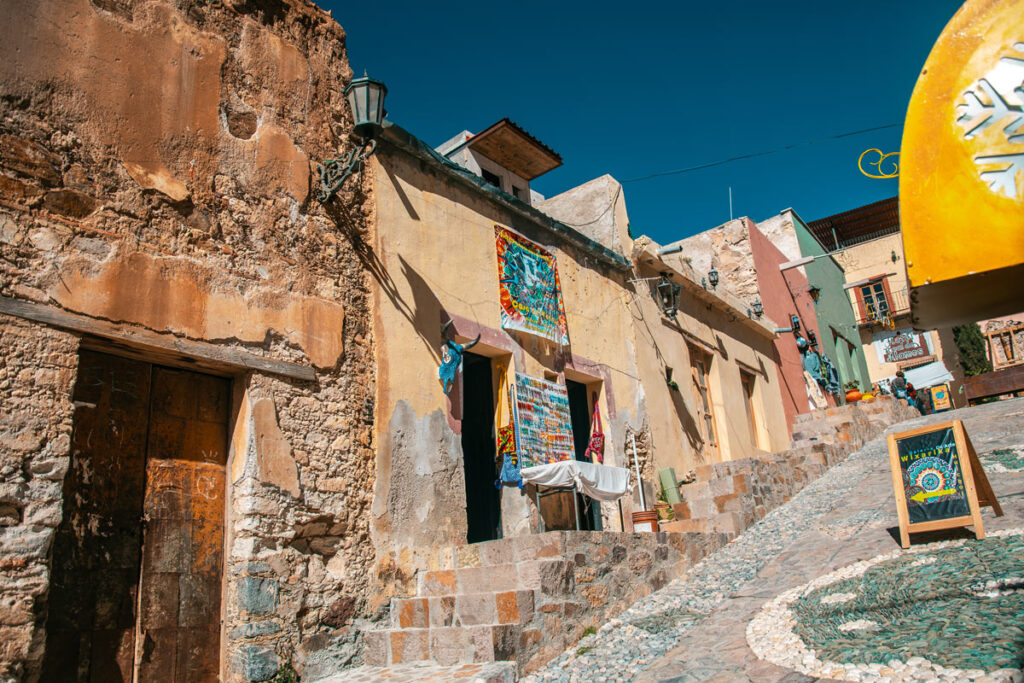
While wandering the main square, I stumbled upon a small shop tucked into a side street—no sign, not on Google Maps, but full of stunning Huichol art. I picked up a Kauyumari, the blue deer, which carries deep meaning in Wixárika stories.
As legend goes, a group of young, starving hunters once chased a glowing blue deer into the desert. The deer transformed into peyote. When they returned with it, the elders divided it among the group, and their hunger and thirst disappeared.
If you’re into symbols and stories, you’ll find plenty here—jaguar heads, beaded snakes, and cow and deer skulls, all covered in tiny multicolored beads placed by hand. Several patterns and creatures come directly from the visions the Wixárika see during peyote ceremonies.
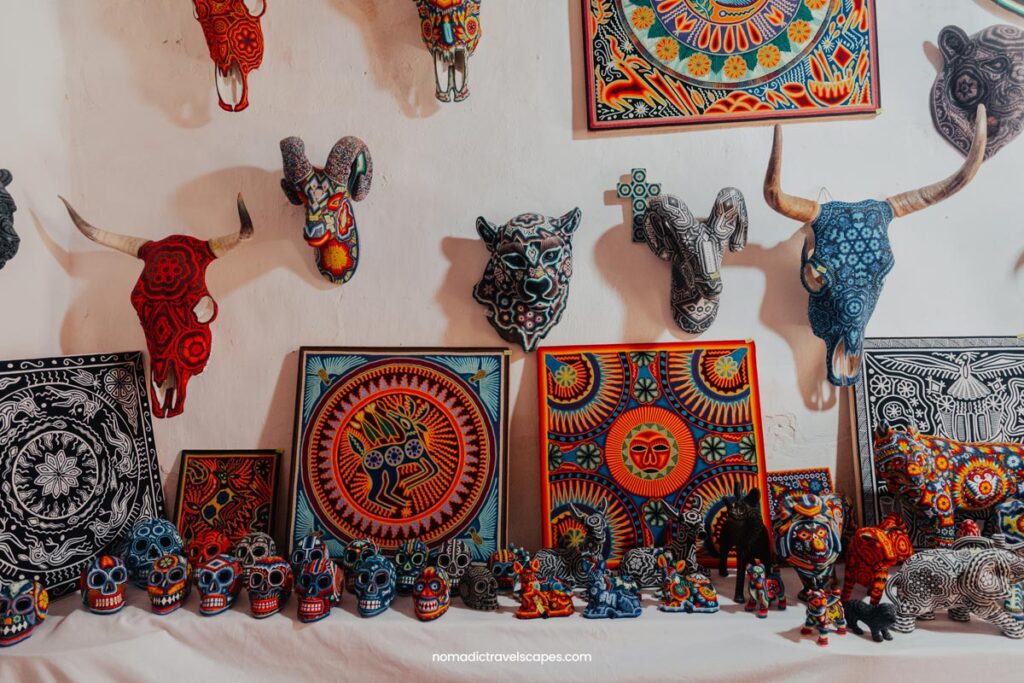
You won’t find the shop online, but if you head toward the main church and keep an eye out, you’ll spot the entrance. It’s worth the detour.
8. Go Ghosthunting in Real de Catorce
If you know me, you know I have a slightly unreasonable obsession with the supernatural. So naturally, when I found myself in a town literally called a ghost town, I had to see if there were any actual ghosts. Real de Catorce has plenty of abandoned ruins, dark tunnels, and eerie tales passed down from tribes to cowboys to modern-day locals.
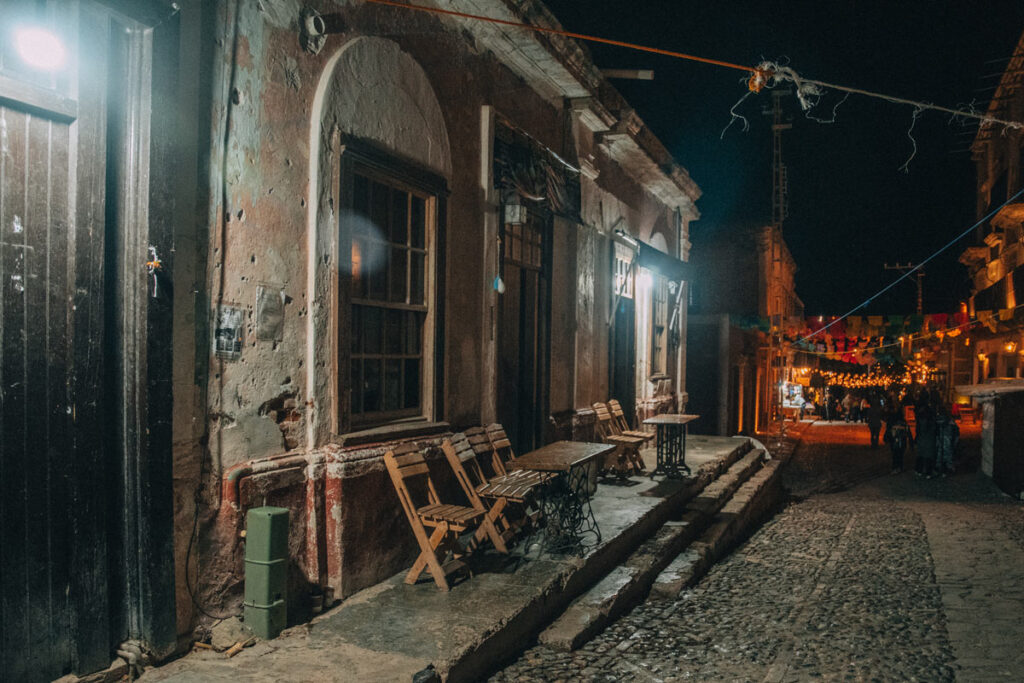
The most famous legend is that of El Jergas, a phantom engineer said to lead miners through the underground tunnels. He’s not malicious—more like a spectral guide trying to help people find silver.
Sightings of “El Jergas.” is the most famous one. There are stories of this phantom engineer, leading people into the mines as he’s allegedly a benevolent spectral guide trying to help people find silver. But there are stories of those who followed his glowing headlamp deep into the mines, only to get lost. His light has even been spotted flickering inside the Ogarrio Tunnel.
Several people have spotted glowing UFOs in its inky skies, so keep your eyes peeled during your nighttime wanderings.
Best Hotels in Real de Catorce
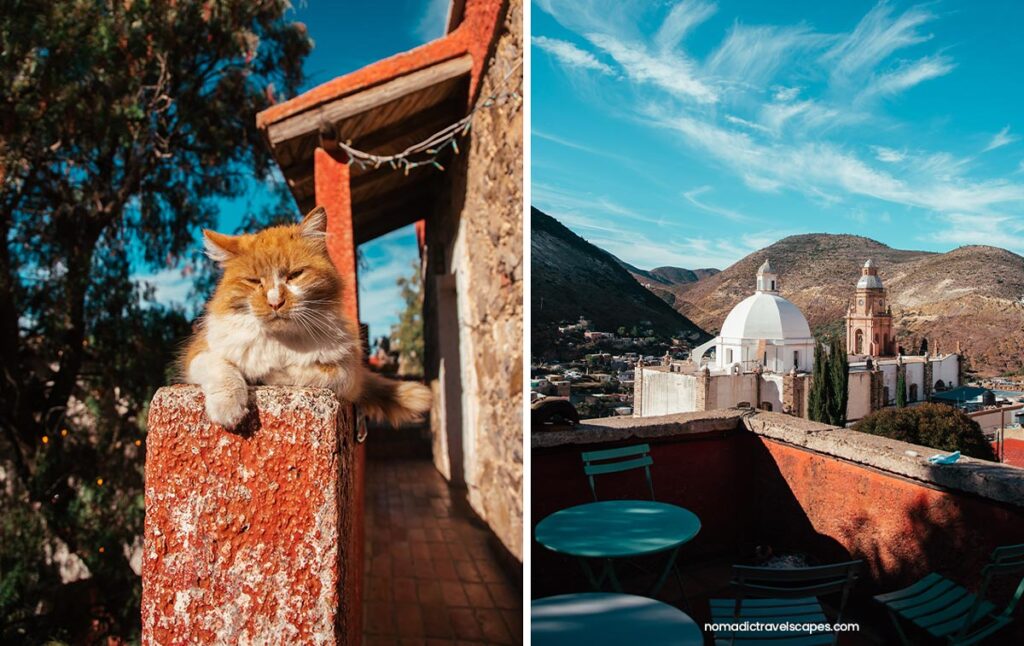
Real de Catorce is home to several fabulous hotels and Airbnbs scattered across town, but if you’re going during a busy season, book early, as the rooms fill up fast, especially around holidays.
I stayed at Casa Sulahue, and honestly, it was the best decision I could’ve made. I found it on Airbnb a week before New Year’s Eve for 31st December, and by some miracle (a last-minute cancellation), one room was still available.
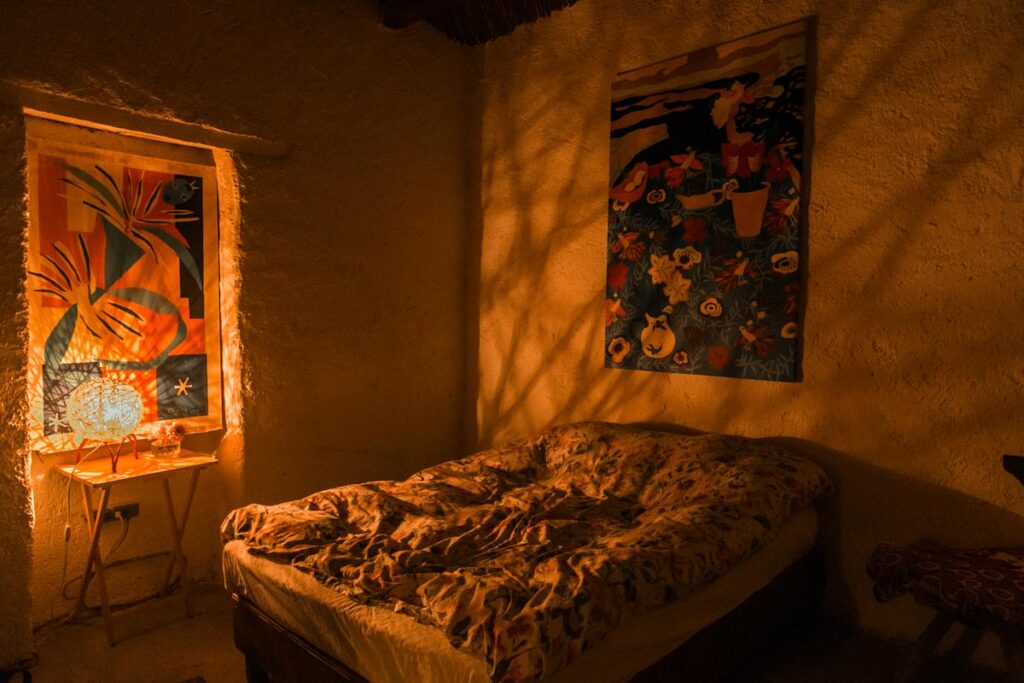
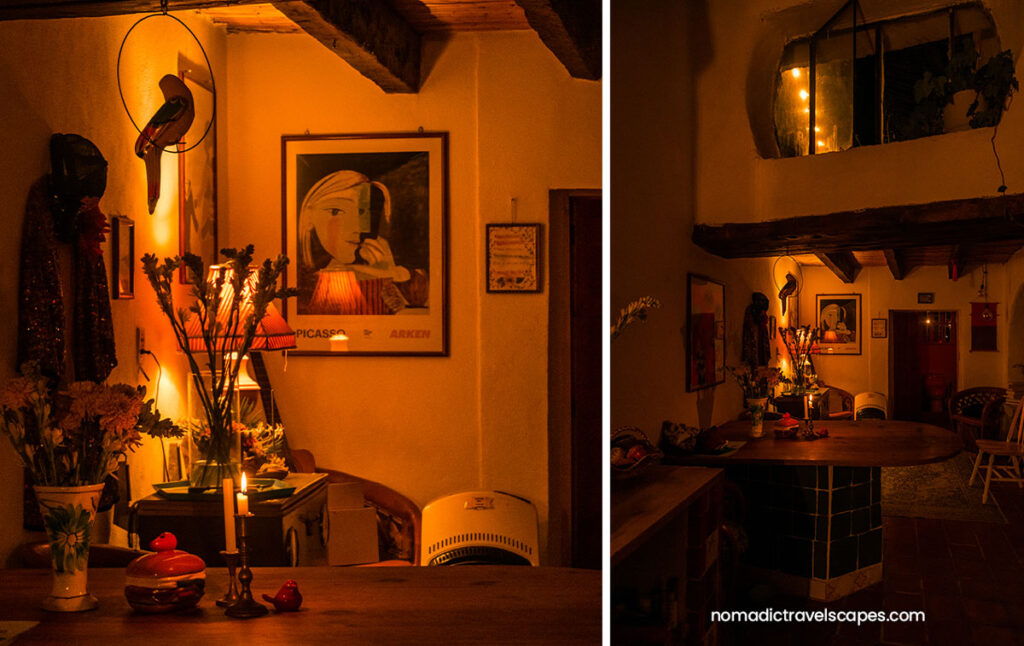
The host is a Dutch-Mexican musician with impeccable taste in design, art, and music. The moment you step inside, you see it reflected in every corner of the space. She also runs live music events in a separate part of the property.
Her place was stunning, cozy, and warm even during the coldest months of the year. Plus it came with two friendly cats who are always available for morning cuddles. It’s easy to spend an entire day on the rooftops snacking on some sweet bread, sipping on coffee and taking in the glorious views of the church.
It’s without question the best Airbnb in Real de Catorce.
Casa Sulahue
📍Matamoros 14, 78550 Real de Catorce, S.L.P.
💵 50 USD – 100 USD ($$)

I also wandered around and checked out a few other stays in town. Here’s a curated list of 2 other great hotels in Real de Catorce.
Hotel Hacienda Encantada
📍 Lanzagorta 54, Centro, 78554 Real de Catorce, S.L.P.
💵 50 USD – 100 USD ($$)

Casa Curtos
📍 Calle Zapata 14, 78550 Real de Catorce, S.L.P.
💵 50 USD – 100 USD ($$)

Where to eat in Real de Catorce:
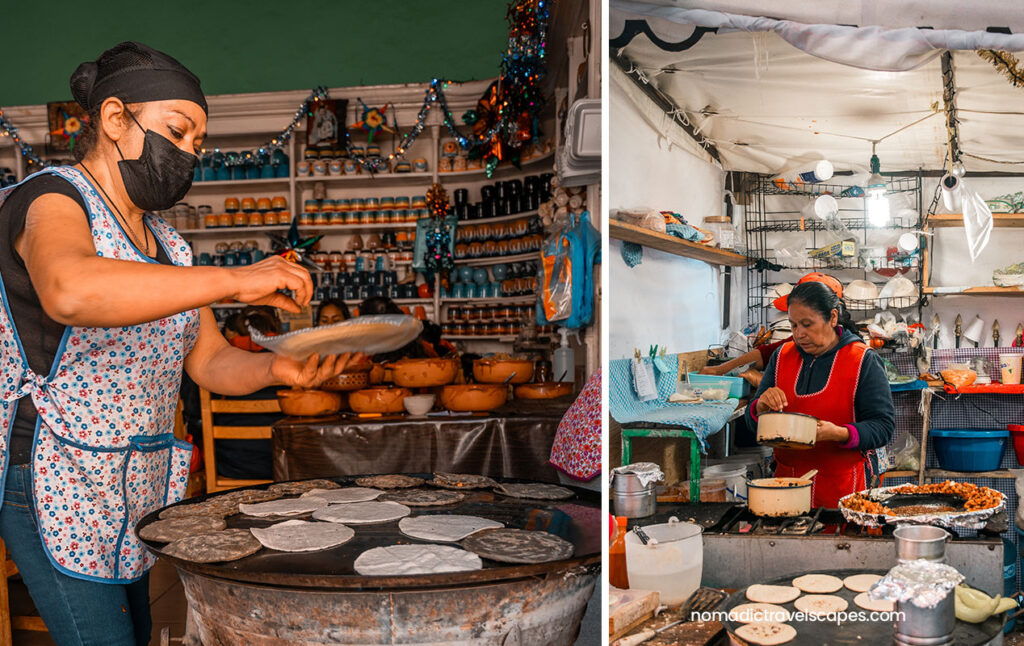
Real de Catorce’s food scene is low-key but spectacular. Prices are easy on the wallet, and options range from traditional Mexican plates to solid Italian comfort food.
In the main square, you’ll find plenty of restaurants and street food vendors wiping up tasty, affordable meals, including plenty of vegetarian options like stuffed gorditas and quesadillas.
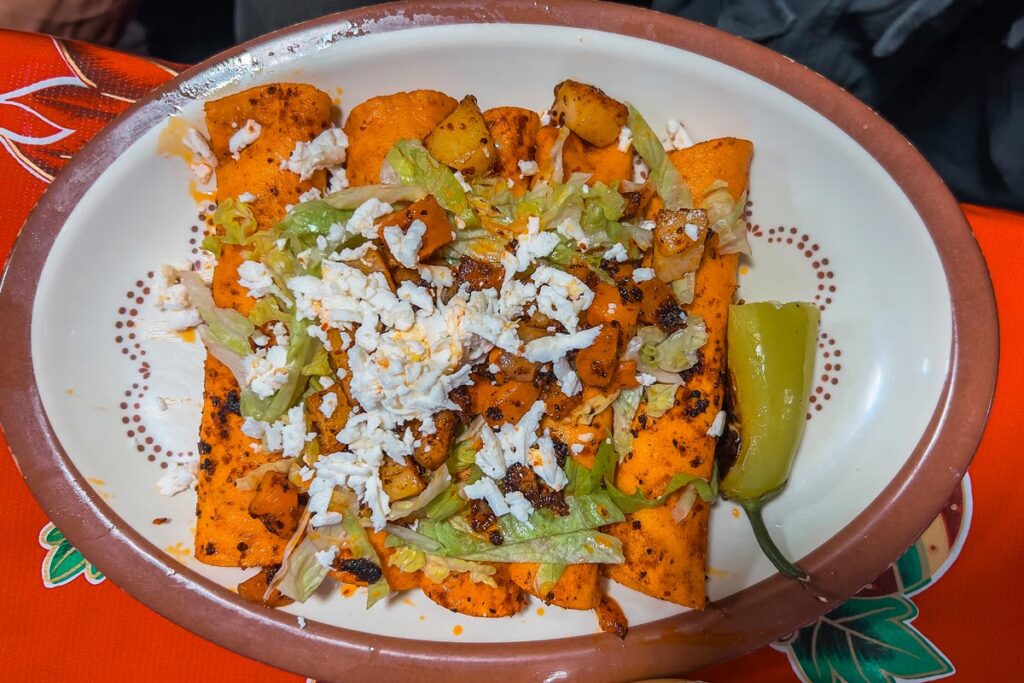
There’s also a small market lined with food stalls dishing out enchiladas mineras, gorditas, esquites, and more. Some vendors use lard (manteca) to cook their refried beans, so if you’re vegetarian or picky about ingredients, ask if they use “carne de cerdo.”
I ate at La Esquina Chata three times, and each meal was yummy. They have saucy pastas, silky house wine, and soft homemade cakes.
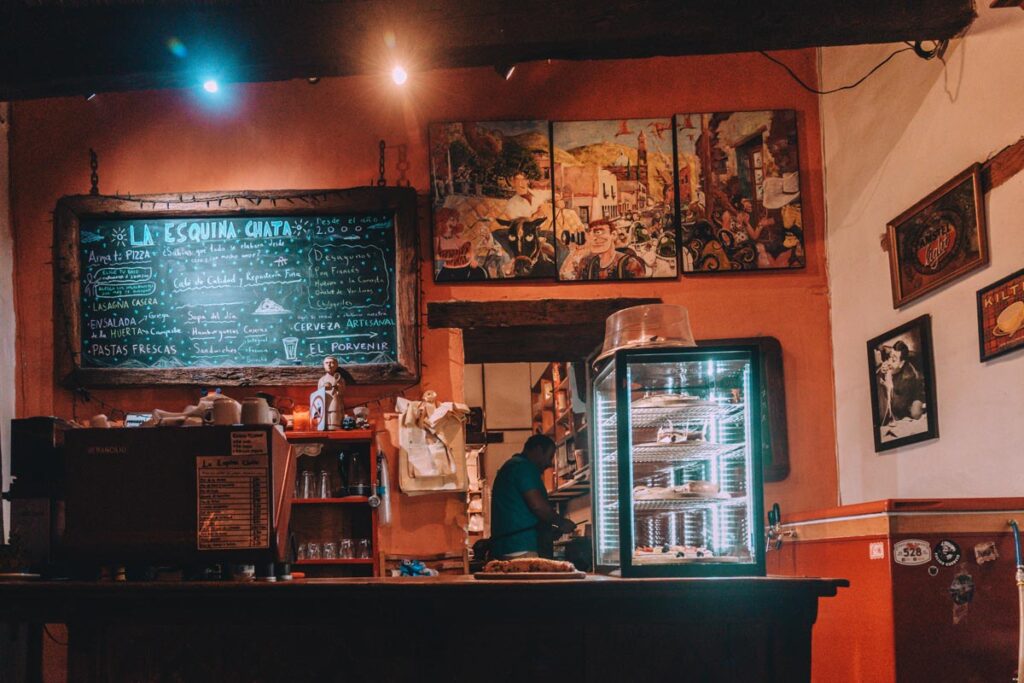
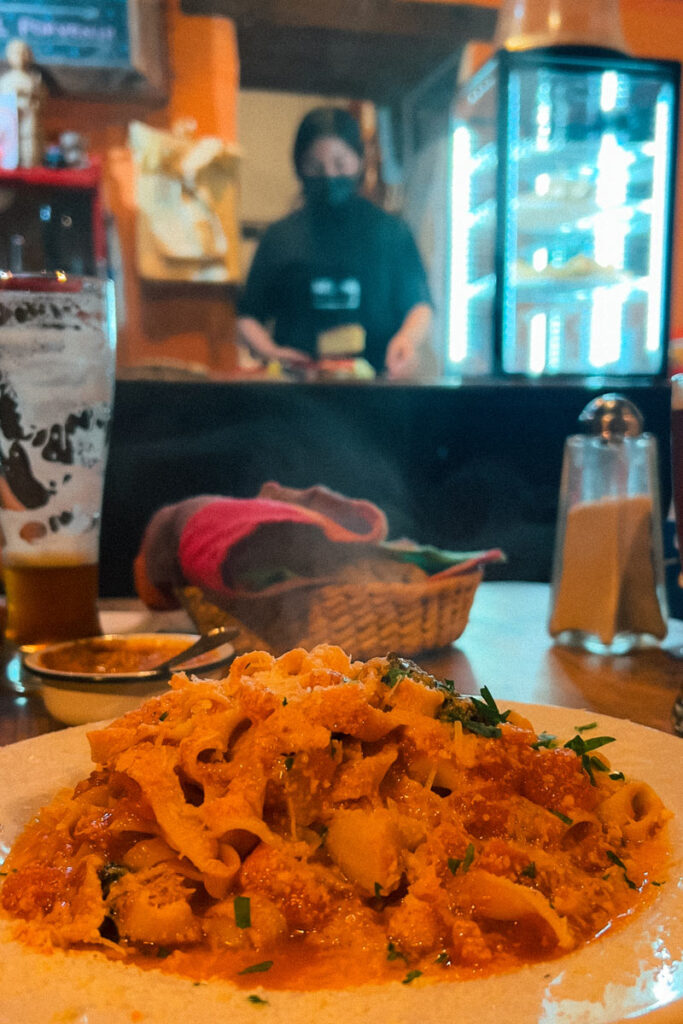

Another spot I’d recommend is Restaurante La Puerta. Their breakfast hotcakes were fluffy, and the Enchiladas Suizas were the perfect cheesy and savory lunch item.
What to Pack for Real de Catorce
Nights in winter get ridiculously cold, especially from November through February. Bring a waterproof down jacket, thick thermal socks, and warm layers for the evenings. Days are usually sunny and dry, so you’ll also want lightweight and airy clothes for daytime wanderings. Summer months can be scorching, so bring tank tops, skirts, and shorts.
Cobblestone streets are everywhere, so comfortable shoes with grip are a must. If you’re planning to ride horses or go hiking, bring sunscreen, a refillable water bottle, and a small backpack for snacks and layers. Wi-Fi is spotty, and the signal drops often, so download maps offline if you’re not planning to stay completely unplugged.
Sample Itinerary for Real de Catorce
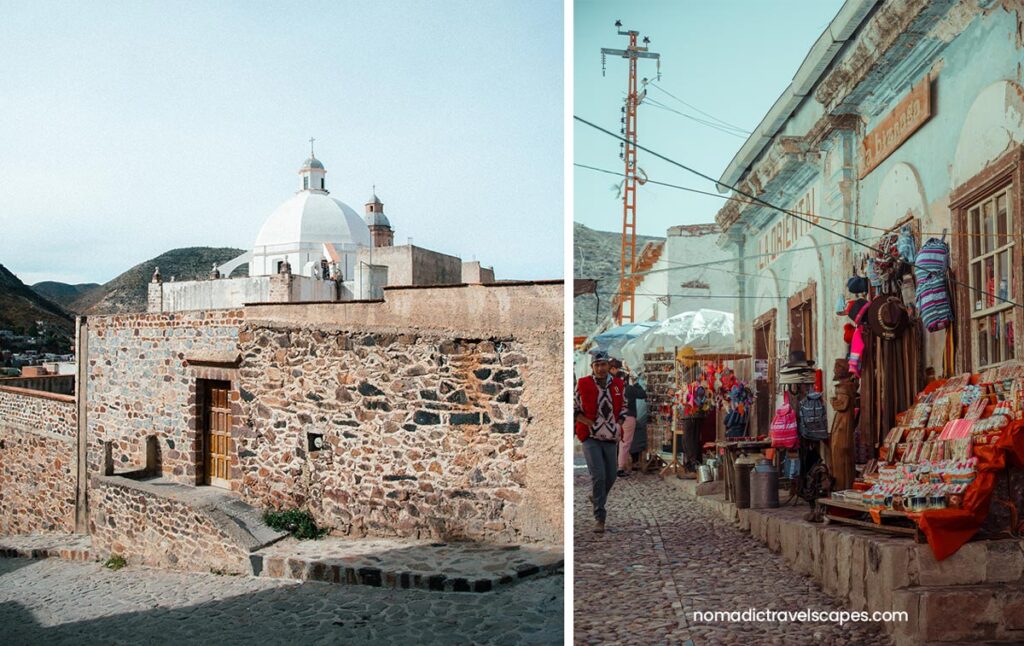
Day 1
Morning:
- Arrive in Matehuala and take the colectivo or taxi up to Real de Catorce through the Ogarrio Tunnel.
- Check into your hotel or Airbnb and drop your bags.
Afternoon: - Grab a gordita or enchiladas at the food stalls in the main square.
- Wander around town, visit Templo de la Purísima Concepción, and explore the side streets.
- If you’re up for it, walk or ride to the Pueblo Fantasma before sunset.
Evening: - Have dinner at La Esquina Chata or Restaurante La Puerta.
- If the night is clear, bundle up and sit on a rooftop or terrace—the stars here are wild.
Day 2
Morning:
- Book a horse ride to Cerro del Quemado (ask around the square or pre-arrange with a local guide).
- Stop at the hilltop Wixárika home if invited, and learn about the blue deer legend and peyote rituals.
Afternoon: - Return to town, rest, or grab lunch at the market.
- If you still have energy, take a Willy Tour to the surrounding desert and old mines.
Evening: - Catch some live music (if staying at Casa Sulahue or another guesthouse with events).
- Pack, rest, and prep for the journey out the next morning.
Pack Your Bags for Real de Catorce
That’s everything you need to know to plan a trip to Real de Catorce.
Use this guide as your base, tweak it to fit your style, and take your time with the place. Bookmark it, share it, or send it to that one friend who’s always chasing desert towns and ghost stories.
If you’ve been here before or are planning a trip, I’d love to hear your thoughts. Leave a comment below with any questions, or stories share your experience of the ghost town of Real.
If you need help planning, want my local guide’s contact, or have questions about where to stay, book a trip consultation with me by emailing hello@nomadictravelscapes.com or drop a comment below.
And if you liked this guide, stick around—I post new travel stories every week!


